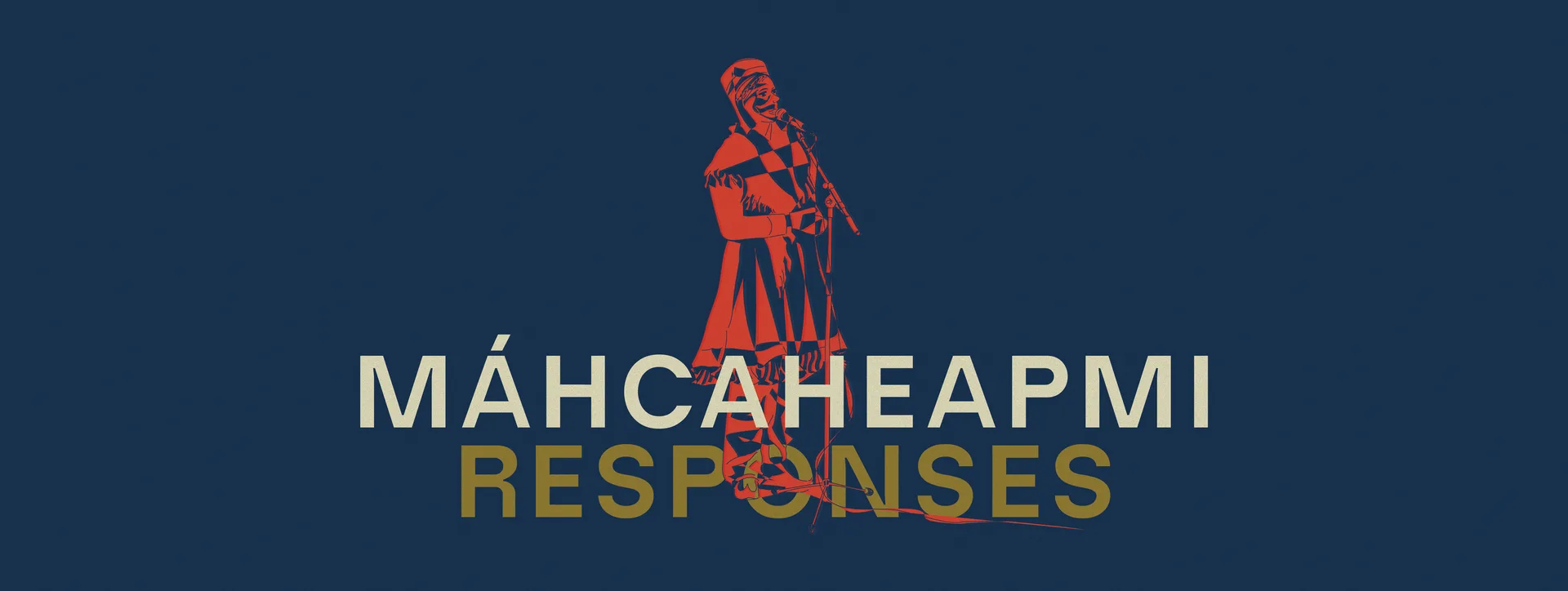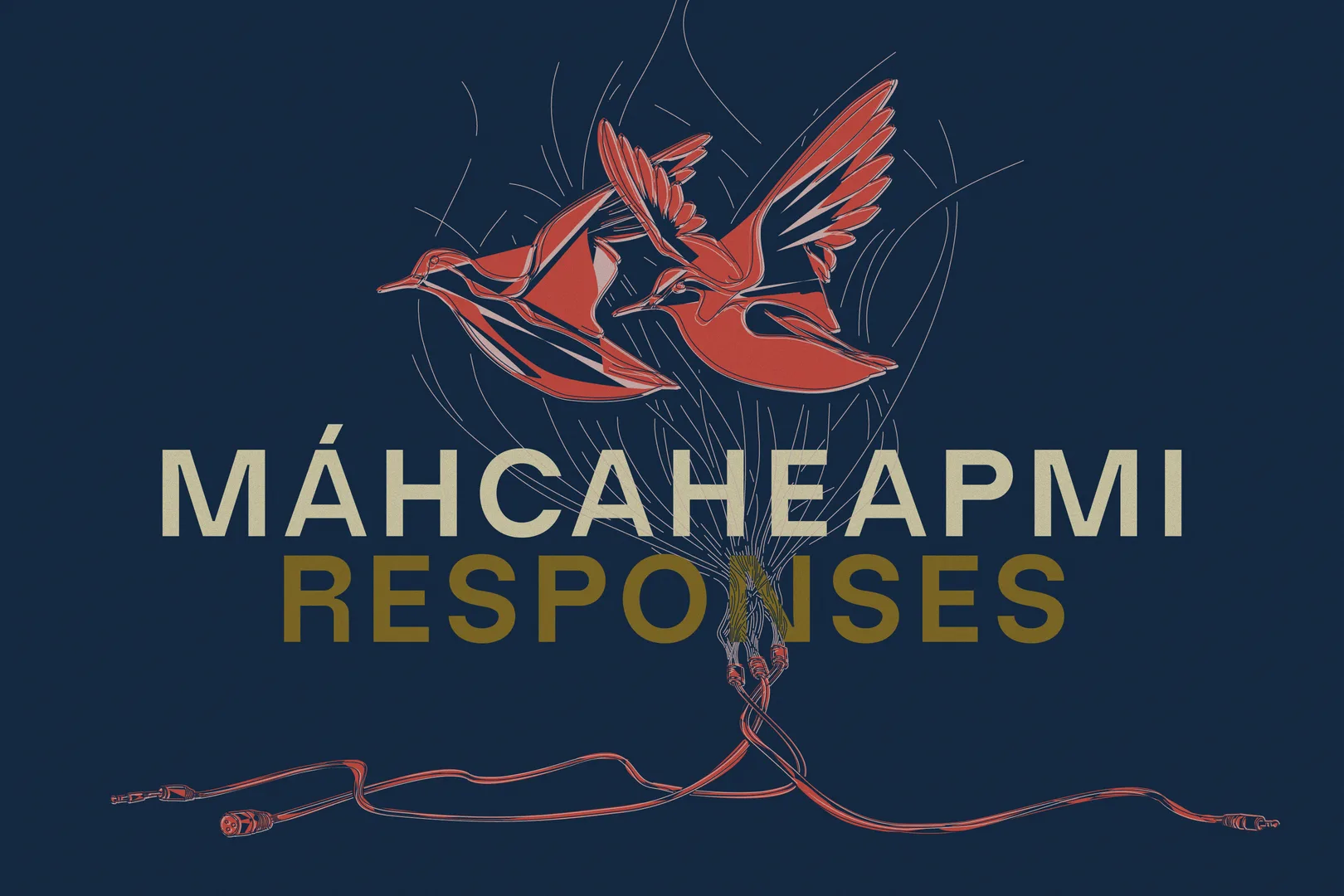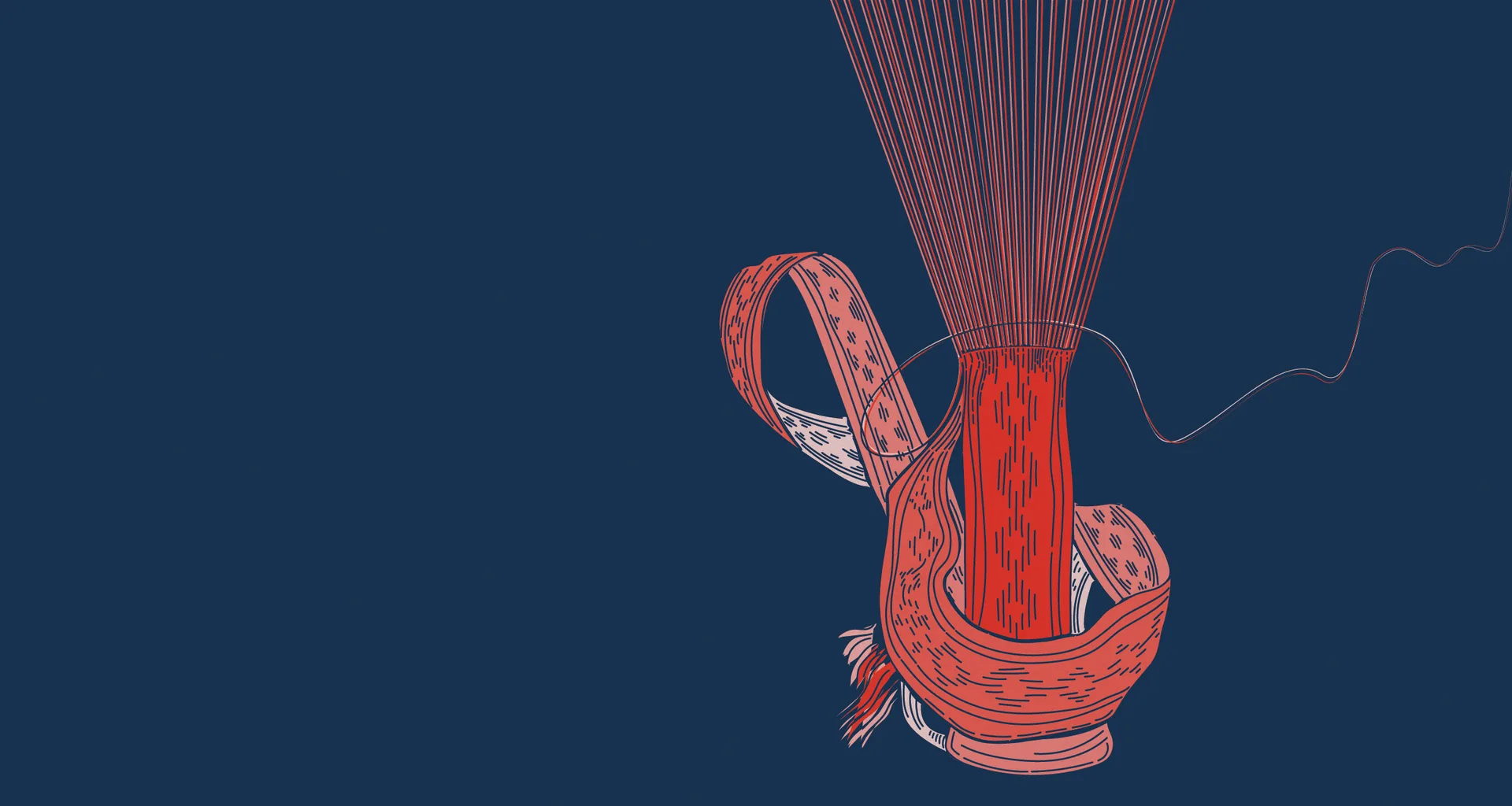
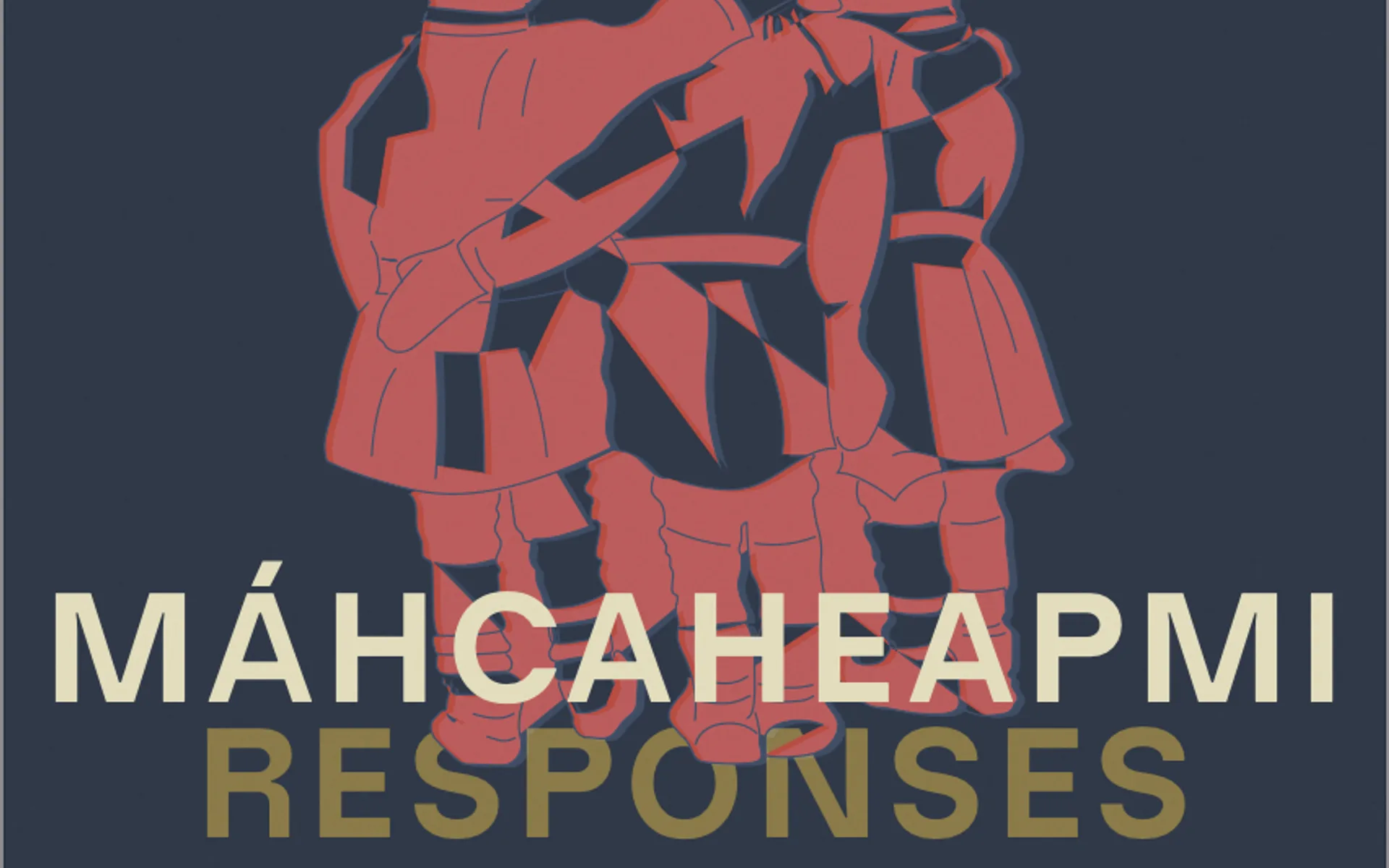
Máhcaheapmi (Responses) #1: Practices of Sovereignty. Art and Resistance in the Sámi and P'urehpecha Nations
The first iteration of Máhcaheapmi (Responses) took place in April – May 2024 in Mexico.
'Practices of Sovereignty. Art and Resistance in the Sámi and P'urehpecha Nations' was a two-part project – consisting of a residency in P'urehpecha territories and a conference in Mexico City – bringing together discussions and artistic practices from the Sámi and P'urehpecha nations.
The project was a collaboration between Museo Universitario Arte Contemporáneo (MUAC) and the Office for Contemporary Art Norway (OCA).
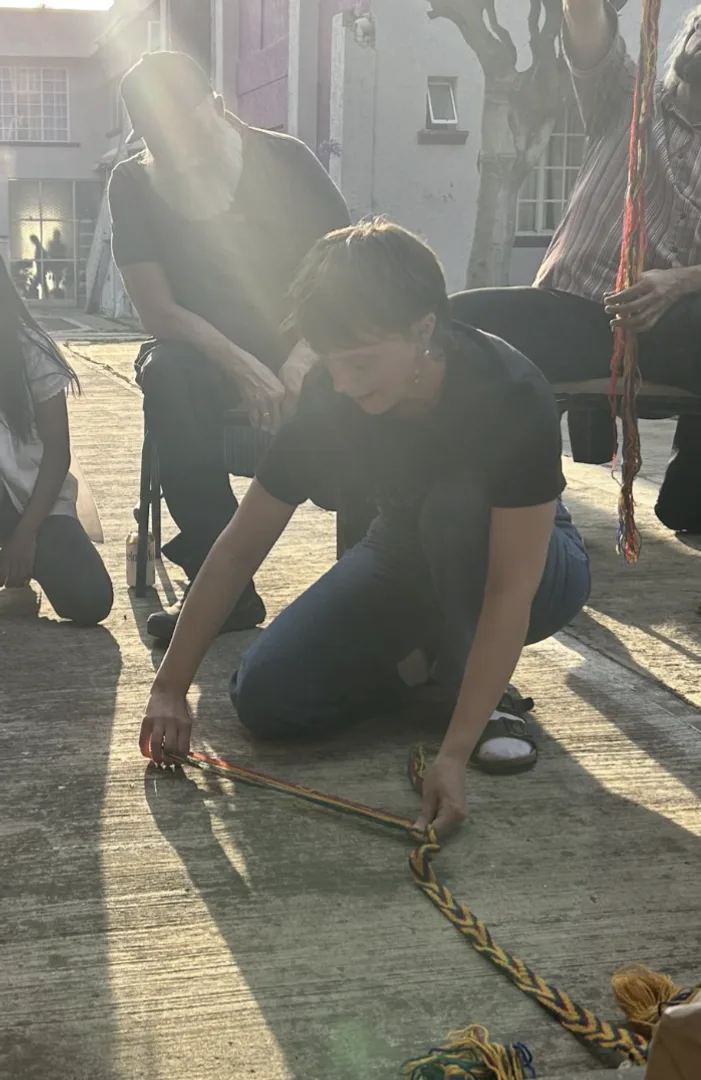
Elina Waage Mikalsen’s workshop on woven belt.
With a delegation of nine Sámi artists and cultural workers, the residency staged a series of exchanges between the Sámi and P'urehpecha communities, focused around Cherán in the state of Michoacán. The P'urehpecha artist group Colectivo Cherani (Bethel Cucué, Giovanni Fabián, Francisco Huaroco, Ariel Pañeda Macías, Alain Silva Guardián) were key participants for this exchange.
These encounters were followed by a public conference at MUAC on 30 April 2024 entitled 'Stories of the Blue Night', where the Sámi participants discussed together with P'urehpecha actors some of the challenges of building indigenous-led cultural institutions., as well as the parallels of resistances with Nation-States.
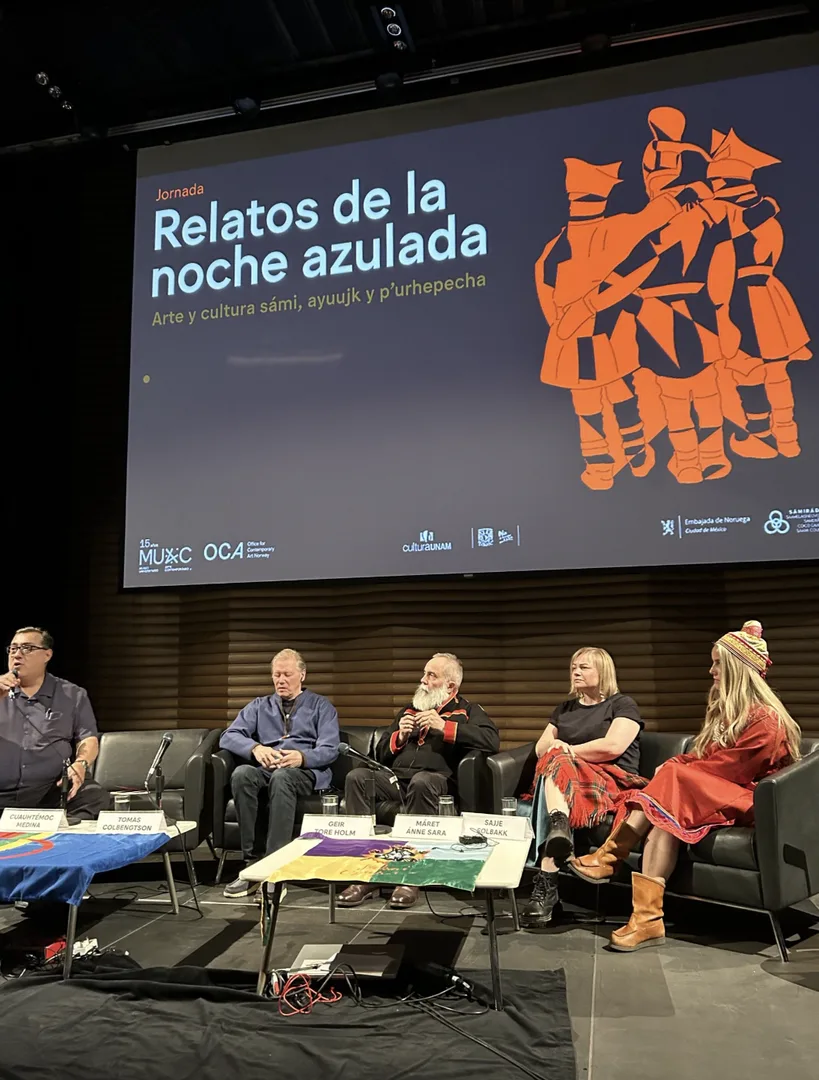
Panel 'Sámi and Indigenous Art in a Global Art World' with Tomas Colbengtson, Geir Tore Holm, Máret Ánne Sara and Sajje Solbakk. Moderated by Cuauhtémoc Medina.
Learn more about the residency, the conference and Colectivo Cherani via the links below:
Máhcaheapmi (Responses) #1: Residency in Cherán K’eri
Máhcaheapmi (Responses) #1: ‘Stories of the Blue Night' conference
Máhcaheapmi (Responses) #1: Colectivo Cherani
Residency participants from Sápmi:
Tomas Colbengtson
Tomas Colbengtson is an artist, holding an MFA in Painting. Tomas is Sámi, from the reindeer herding people of Scandinavia. Tomas is born and grew up in a small village near Björkvattnet in Sweden, close to the polar circle. In his artwork, he asks how colonial heritage has changed indigenous lives and landscapes, both of the Sámi and other indigenous peoples. Struggling to revitalize his mother tongue, the South Sámi language, he works with visual art, using sámi history and collective memory as the source to his art. His work with print-making on different materias that cast shadows can be read as a metaphor for governmental invisibility of Sámi people and culture. Tomas has exhibited internationally, as well as creating many public artworks in Scandinavi.
Eva Marie Fjellheim
Eva Marie Fjellheim is a southern Saami researcher, writer, and radio documentary producer working on decolonial struggles and solidarity across Indigenous geographies. Fjellheim holds a PhD from the Centre for Saami Studies at UiT - the Arctic University of Norway. She has a broad background from working with Indigenous peoples’ issues, focusing on Indigenous peoples’ land rights and conflicts caused by extractive industries. Her PhD research focused on dispossession of Saami reindeer herding lands by the wind energy industry in Norway as a form of green colonialism. She also works to strengthen networks, collaborations, and solidarity between Saami and Indigenous peoples' struggles abroad, especially in Latin America. Fjellheim also teaches, writes chronicles and essays, engages in public debates, and does journalistic work to build knowledge on Saami and Indigenous issues. Together with her collective Søstrene Suse and the feminist radio station Radiorakel, she produced the documentary I Elsa Laulas fotspor (In Elsa Laula’s footsteps) about Saami women and their struggle against racism, assimilation policies, extractive industries, and state regulation of Saami reindeer herding and fishing.
Geir Tore Holm
Geir Tore Holm (b.1966 in Tromsø), an artist, grew up in the Sámi community of Olmmáivággi/Manndalen, Gáivuotna/Kåfjord. He lives and works at Øvre Ringstad Farm in Skiptvet, Østfold. Graduated from Kunstakademiet i Trondheim in 1995. With Søssa Jørgensen he established Sørfinnset skole/ the nord land in Gildeskål, Nordland in 2003. Geir Tore Holm was head of project in the founding of Kunstakademiet i Tromsø–UiT in 2007. From 2009 until his dissertation in 2017, he was a fellow in artistic research at KHiO–Oslo National Academy of the Arts with the project Poetics For Changing Aesthetics. Included in his artistic practice he is active as curator including projects as Sámi Art Festival 2002, River Deep, Mountain High, SDG–Sámi Center for Contemporary Art, 2002, ČSV–Sápmi visualized, Galleri F15, 2005, Obzidian Gaze, Riddu Riđđu Festivála 2016 and Nils-Aslak Valkeapää/Áillohaš, Henie Onstad Kunstsenter, 2020. He is a holder of Norwegian Governments Guaranteed Income Grant and receiver of the John Savio Prize of 2015.
Petra Laiti
Petra Laiti (Mihku Ilmára Mika Petra) is an activist, essayist and musician originating from Anár, Sápmi. Laiti has an extensive background in politics and indigenous rights, having been involved in multiple Saami NGOs, Finnish student politics on a national level, and working as a political assistant to the Finnish Minister of the Interior. Laiti currently serves as a member of the Sámi Council and works with the Nordic Amnesty's on green transition and human rights violations. In the cultural field, Laiti has predominantly worked as a funding advisor for Nordic Culture Point, a cross-border funding mechanism for Nordic cultural projects. In recent years, Laiti has also taken up curating, and often serves as a freelance consultant to various institutions looking to exhibit Saami items or organize Saami events. In the music world, Laiti publishes solo work as well as works in Article 3, the only all-female, all-Saami DJ collective.
Dine Arnannguaq Fenger Lynge
Daily and development manager, Dáiddadállu - Sami artist network. Dine was born and raised in Qaqortoq, Kalaallit Nunaat with a father who is Inuit and a mother who is Danish. Since 2018, Dine has worked as General Manager in Dáiddadállu in Guovdageaidnu, Sápmi and worked to develop Dáiddadállu's administration, operations, projects etc. In close collaboration with the board and their artistic professional competence, Dine has worked to develop the collective's administration, take care and develop Dáiddadállu’s visions in establishing an institution and space where interdisciplinary Sámi artists can develop each and together professionally in their own terms.
Elina Waage Mikalsen
Elina Waage Mikalsen (b.1992) is a Sámi-Norwegian interdisciplinary artist and musician from Romssa/Tromsø, Sápmi. She works with sound, text, textile, performance and installation. She often mixes field recordings, voice, electronics and home-built instruments to create sonic spaces that exist somewhere between reality and fantasy. She holds a MA in fine arts from Oslo National Academy of Arts from 2021. She has exhibited and performed nationally and internationally in places like Henie Onstad Kunstsenter, MUNCH, Charlottenborg Kunsthal, Nuuk Art Museum, Cultural Centre Caisa, The National Museum in Norway, Lofoten International Arts Festival and Singapore Biennale. The last two years she has been an artist in residence at Borealis festival for experimental music, focusing on Sámi sonic practices, ways of listening and experimenting.
Anne May Olli
Anne May Olli is director at the largest Sámi museum in Norway, RiddoDuottarMuseat (RDM), that consists of 5 local museums in the western part of Finnmark in Northern Norway. The administration is located in Karasjok, at the museum Sámiid Vuorká-Dávvirat. She holds a Master in Conservation from the University of Oslo (2013), as well as a Master degree on pesticides in Sámi museum collections. Olli has worked as a Conservator at one of the local museums in RDM for many years, with emphasis on documentation of traditional Sámi technology and its use in conservation. She is also a farmer, with milk-production and her husband is a reindeer pastoralist.
Máret Ánne Sara
Máret Ánne Sara (b.1983) is an artist and writer who comes from a reindeer herding family in Kautokeino, Northern Norway. She is the initiator and founding member of the Sámi artist collective Dáiddadállu. She was nominated for the Nordic Council’s Children’s and Young Literature Prize in 2014 for her debut book Ilmmid gaskkas. Sara has exhibited visual art since 2003 and often deals with political and social issues affecting the Sámi community, the reindeer herding Sáami community in particular. Sara is dedicated to Sámi subjectivity in art and reality. Her art is amongst other, acquired by the Norwegian national museum where it holds a central place in the entrance hall. Sara has exhibited internationally, amongst others,at Documenta 14 in Kassel in 2017, at the Venice Biennale in 2022.
Sajje Solbakk
Sajje Solbakk is festival director for the international Indigenous festival Riddu Riđđu. Riddu Riđđu has a broad program over four days with concerts, courses, debates, seminars, film, dance, children's festival, youth programme, theater and art exhibitions. Each year, the festival presents self-produced commissioned works. In addition to the festival that is organized in July in Kåfjord, Riddu Riđđu works all year round to highlight Sami and indigenous art and culture both nationally and internationally. Solbakk has a background in journalism and is the host of the podcast, Gozuid alde, together with activist and artist, Ella Marie Hætta Isaksen.
